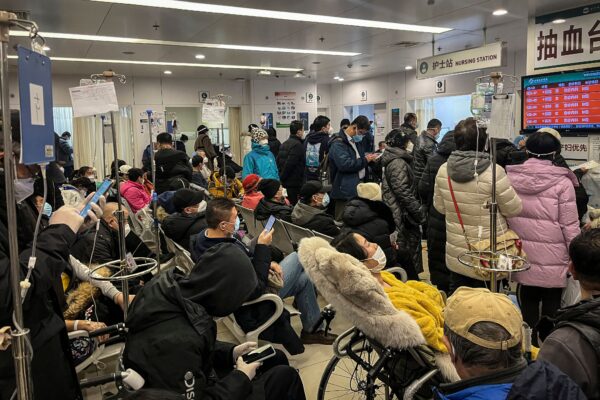A chartered plane carrying 210 tourists from mainland China arrived on the Indonesian resort island of Bali for the first time after three years of COVID-induced border restrictions imposed by the Chinese communist regime.
The Lion Air flight departed from Shenzhen and landed at an international airport in Bali on Jan. 22, the first flight since the Chinese Communist Party (CCP) eased its travel restrictions on Jan. 8.
Indonesian Ministry of Tourism and Creative Economy official Ayu Marthini said Indonesia expects to receive 255,300 tourists from China this year. The country received 94,924 Chinese visitors from January 2022 to October 2022.
“However, the targeted number of Chinese visitors can hopefully be exceeded, and if possible, it can be similar to that of 2019,” Marthini said, according to local media.
Indonesia has maintained its lax entry requirements, while other nations—such as the United States, Japan, and Malaysia—have imposed COVID-19 entry rules for arrivals from China because of the rise of COVID-19 infections in the mainland.
In December 2022, Indonesian President Jokowi Widodo downplayed the possibility of an increase in COVID-19 cases brought on by foreign travelers, citing the immunity of the country’s population to the virus.
“As long as our serosurvey shows results above 90 percent, which means we already have proper immunity, then whatever comes our way won’t be a problem,” Widodo was quoted as saying by The Jakarta Post.
China is one of the largest markets for inbound tourism in Indonesia. The return of Chinese tourists is expected to support the overall target of foreign tourist arrivals this year. Sandiaga Uno, minister of Tourism and Creative Economy, said Indonesia aims to record 3.5 million to 7.4 million foreign visits.
China’s Lack of Transparency in Data
There has been growing concern over the veracity of the CCP’s data reporting of its outbreak, following reports of overcrowded hospitals and funeral homes after the CCP abruptly abandoned its draconian zero-COVID policy in December 2022.
The World Health Organization (WHO) had urged the CCP to make public the number of infections and deaths in China. Dr. Yan Limeng accused the CCP of covering up data on infections and the virus in China.
The recent spread of COVID-19 has caused significantly more severe symptoms in China when compared with other countries, and the death toll is extremely high, according to Yan.
She was a member of the WHO influenza H5 Reference Lab based at the University of Hong Kong School of Public Health before she fled to the United States after questioning the origin of the COVID-19 virus.
Chen Cao, a viral disease researcher at the Chinese Center for Disease Control and Prevention, said at a press conference on Jan. 13 that 19 evolutionary branches of the Omicron coronavirus variant have been detected in the country from Dec. 1, 2022, to Jan. 10.
According to Chen, the subvariants of BA.5.2 and BF.7 are the two dominant ones, accounting for 97 percent of the total 19 branches detected during the time. Chen didn’t give more detail on the 19 subvariants.
But it doesn’t make sense that the same variants have resulted in such a different pandemic outbreak in China and the world, Yan told the Chinese language edition of The Epoch Times in an exclusive interview on Jan. 10.

“We have already found subvariants BF7 and XBB overseas. The Chinese communist regime has claimed that the subvariants found in China are the same as those found abroad. It is very unreasonable if they are the same variants, as they have caused symptoms [in China] that are much more severe than in foreign countries,” she said.
Yan, a postdoctoral researcher specializing in virology and immunology at the University of Hong Kong before fleeing to the United States, said researchers had found a very slight change—immune escape loci—after a genomic sequence analysis of the virus carried by Chinese travelers to Italy.
“When we talk about Omicron, it has shown some common characteristics during the past year: it mainly damages the upper respiratory tract and barely enters the lungs. So many people may think that Omicron isn’t that deadly,” Yan said.
However, this isn’t necessarily true with all its subvariants, she said.
“If some of its subvariants mutate in some special loci, the subvariant must be regarded as an independent one, although it is still a subvariant of Omicron,” Yan said.
“For example, like in Italy, we have found through genomic sequence analysis the immune escape loci in the [Omicron] subvariants carried by Chinese travelers. That is to say, although these Omicron variants look very similar to the Omicron we have known previously, they have a small change that mainly arises in this locus that can cause immune escape. Once the virus escapes the immunity, it causes more damage to the human body.”
She noted that this is why China’s COVID-19 cases are more severe than in other countries.
Regarding immune escape, Yan explained that most of the Chinese people should’ve had some comprehensive antibodies after the three years of the pandemic outbreak in the country.
“But the variant strains will bypass these antibodies, and your body will be equal to having lost its defense against this virus again,” she said.
Sophia Lam and The Associated Press contributed to this report.


